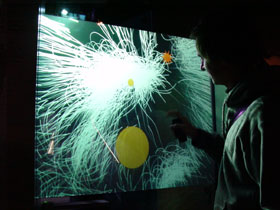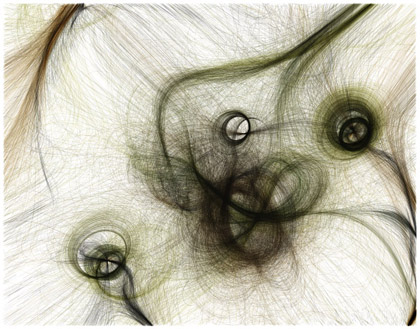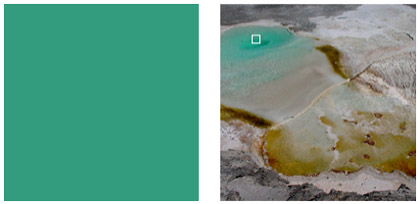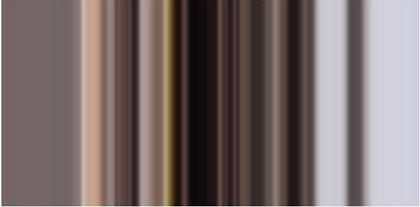 |
[October 10th 2003]

Casey Reas at the Ars Electronica symposium 2003.
Code.
In Conversation with Casey Reas
Casey Reas is an artist
exploring abstract kinetic systems through diverse digital media.
He is an associate professor at the Interaction Design Institute
Ivrea in Italy and received his M.S. degree from the MIT media lab
where he was a member of John Maeda's Aesthetics and Computation
Group. Casey Reas performed a central role at this years Ars Electronica
festival, at which he contributed as symposium moderator, speaker,
workshop participant as well as exhibiting artist. Interview by Sebastian Campion, Ars Electronica
festival, Electrolobby September 9, 2003.
Casey, at first view, the festival theme CODE
seems very straightforward but a second view suggests that it is
more ambiguous. It can imply 'social code', 'aesthetic code', 'political
code', and 'software code' etcetera all depending on how you look
at it. What does CODE mean to you and how does it reflect your work
practically and conceptually?
For me CODE is software. The important aspects are the concepts
and desires, which are temporarily encoded as text, but come alive
again as the software is executed. I need to code to make the work
I desire.
You have three different kinds of artworks exhibited at the festival:
A user-responsive installation, a generative installation and some
print works. Can you say a few words about these pieces individually
and collectively?
First of all, the generative piece MicroImage is in fact
two different pieces. In the one piece it is the same code running
on all three machines with the idea of showing how it produces different
processes and results. Although each one is identical programmed
it showed how diverse the manifestation effect of that code is.
But today it is running a slightly different version, where the
original software is on the left and two different interpretations
of that software on the right. I always write software that is very
interactive but lately, instead of having the audience interact
with it, I am the person who interacts with it, meaning I am taking
more control. It is something new that I am doing right now. The
responsive installation Tissue is in essence the same code.
The important part of the code is identical but it is interactive
so you can control the environment in which the software responds
to.

MicroImage, generative installation. Triptych
of software. Different forms emerging out of the same software code.
Running on plasma screens at the Ars Electronica festival. http://www.groupc.net/2003/microimage/index.html.

Tissue, responsive installation. Visitors
interact via the Responsive Window system created by MIT's Responsive
Environment group. http://www.groupc.net/2002/tissue/index.html.

Tissue, print. Archival Epson paper with archival
Epson inks. Size: 11" X 14"
I like to manifest the software in different media because each
media gives me some sort of different way of presenting a thought
or a concept. When presenting the software as running software,
as interactive software, it allows me to explore the domain of response.
Doing it as a print allows me to explore a new level of materiality
and tactile quality, which is not possible in screen based media.
All the work that is being shown here explores being able not to
have control over the machine. So, in essence, it's the same software
but each media gives me a different way of exploring a piece of
code.
Some of your other work, which is not exhibited here, is not
entirely based on written code but also on photographic images.
What is your interest in the image as source material?
The reason I find images so interesting is because they have inherent
structures that are really sophisticated. I did a series of pieces
based on images and the idea was to explore what is a digital image.
Basically, the digital image is a series of data. It's just a series
of numbers, like each pixel has an RGB value: red, green and blue
ranging from zero to one or 255 depending on how you scale it. In
Cinema Image I was experimenting with different ways of representing
the same image. The exact same data is presented in a different
order and all of a sudden it is perceived in an entirely different
way. I worked with the same concept in Scanner. The pixels
are a separate process and they're reading the colors from the image
below and the color currently read is being presented on the left.
It's sort of a two dimensional version of Cinema Image.

Cinema Image
By exploring the surface of a two-dimensional digital image unit
by unit, it is transformed into a time-based one-dimensional experience.
Structure is revealed through time rather than space. http://groupc.net/sketches/ci.html

Scanner
Reading the surface of an image to extract colors
http://groupc.net/sketches/scanner.html
You have created still images - print works -
from your generative 'running' software and in your photography-series
you reverse that process and create animations from still images.
Yes, these animation pieces allow me to explore choreography and
have total control over how the image unfolds in time. Another piece
Mediation is more or less the same as Scanner and
Cinema Image but it's animated differently. The interesting
thing is not the code or the process but the image that you select.
You can sort of move to different kind of spaces within time by
selecting images in a different way. Computational it's not very
interesting at all but by carefully selecting certain images and
cropping them in certain ways I create different rhythms and patterns
in time. The code works on any image but I think it is only significant
if it is extremely carefully selected.

Mediation
Mediating the relationship between a photograph and its viewer by
systematically obscuring all representational and symbolic content.
http://www.proce55ing.net/learning/examples/linear_image.html
http://groupc.net/2002/mediation/index.html
The images you select seem to depict organic
material or natural systems something, which is also very visible
in your generative pieces.
Yeah, I do have an interest in natural systems. In the past a lot
of artists have made abstractions of the physical world and how
it exists. I am really interested in making abstractions of the
processes of the physical world. Abstractions of the behavior of
natural systems. So my interest is really in the behavior of how
they work, rather than how they look.
Is it an interest you developed while studying at the aesthetic
+ computation group at MIT? Although your work is conceptually
different, it seems you share an interest in the relation between
computer, software and organic material with Golan Levin and Ben
Fry, whom you studied with.
Yeah, I mean within those people you mention there's a number of
common threads just because were all sitting in a room through 1-2
years working very closely. So of course some sort of discourse
emerges from this.
And what did you do before you went to MIT?
Before...I did...a number of things ha-ha… I started as a Graphic
Designer in New York. I was a visual communication designer, always
focusing on system design. Hands on! I was designing book and print
systems basically, and that led very easily into designing for the
Internet, because there it was like still designing systems but
designing them in a way that was a bit more dynamic than in print.
Then I wanted to be even more fluid and dynamic and that's when
I started writing software. So, it's sort of a gradual progression
of designing systems that were static, that were more flexible and
then, now, software systems that can be very responsive and very
fluid and has a lot more aspects to explore.
Did you program at that time?
No, I started only 4 years ago, maybe 5 now.
So you didn't start as a teenager coding Amiga or Commodore like
the 'programmer myth' dictates?
No, no… I am not a lifetime programmer. I didn't even know
what Amiga was until a very short while ago!

Processing
Basic examples of the processing language developed by Casey Reas
and Ben Fry. http://www.proce55ing.net
Perhaps one of your more ambitious projects is
Processing, which is also featured here at Ars Electronica. It's
a programming language and software environment that you are developing
with Ben Fry. When and why did you start this project?
We began 2 years ago, I guess, actually, I have been programming
for 5 years then. Ha-ha... time flies! Ben and I are both teachers
doing all our work in software and we are really frustrated with
the current software environments that exist for doing this kind
of work. Nobody has really designed a software environment for working
in the way that we like to work, so that's why we started building
it. We always worked in software environments like C, C++, Java,
and OpenGL. These environments are too complex. They're trying to
do everything so they're just massively difficult to use. And what
we need is just something that is specifically tailored for the
work that we want to do. So in our language for example, we have
a simpler and better control over color than any other programming
language that I have ever seen before. So it's specifically designed
for the things we find important.
An artistic tool?
Yes, it's specifically made for what we call electronic arts. Oh,
and it's very good for connecting electronics to computers as well.
So you're able to connect a camera or connect two computers together.

Processing
Basic examples of the processing language developed by Casey Reas
and Ben Fry. http://www.proce55ing.net
Is it possible to learn without any previous
programming knowledge?
It has three different learning levels. In the most basic layer
you're able to type in just a few lines of code and see a result,
and the next layer there's a slightly larger structure that allows
you to do things that are responsive and things that can be animated.
And then, in the third layer, you are actually programming in Java
itself. We taught a lot of workshops were we had people who had
never learned to program before and after just two weeks they were
doing really nice works. Another really important thing about the
language is that we have designed it slowly over 2 years, and we
have always been teaching with it and using it personally the whole
time, so it grows very organically.
I heard Golan Levin quote John Maeda, saying something like "When
you use other people's software you live in somebody else's dream".
Do you recognize the quote? - Are 'processing users' living in your
dream?
I don't know this quote directly, but it makes sense. There are
many levels of software from the general to the specific. As software
becomes more specific, it limits the possibilities. Processing
is very general and doesn't put many constraints on the possibilities
of software. In many respects Processing is living in the
dream of Java and OpenGL. It's more a collage of ideas than a specific
revolution…
More…
Casey Reas: http://www.groupc.net
Processing: http://www.Proce55ing.net
Ben Fry: http://acg.media.mit.edu/people/fry/
MIT aesthetics + computation group: http://acg.media.mit.edu/
John Maeda: http://www.maedastudio.com/
Golan Levin: http://www.flong.com/
|
 |
|